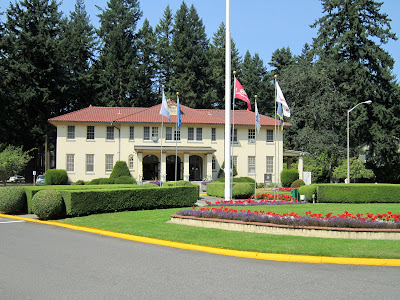
Arriving in Shanghai, we see billboards and signs advertising Expo 2010; on traffic signs, billboards, and buildings. Expo's mascot is the blue "gumby" figure and Shanghai is proud to be hosting Expo - for the world, but most importantly, for China: "Better City, Better Life."

The Expo's iconic image is their own China Pavilion. As the official program says, "with the traditional Douguan Bracket and the concept of nine-folded script (a type of ancient Chinese calligraphy) it showcases the spirit and disposition of Chinese culture. This pavilion is visible throughout the landscape, from all views, taller and bigger than everything else - clearly a symbol of China's emerging position in the world.

The number of people at the Expo was staggering - and most often, we were the only non-Asians in view. People waved at us and took our photo as we stood in lines (for hours) and took photos of them. Everyone carried umbrellas (more like parasols) against the searing sun (and it's not even summer!). At first, I was chagrined to be carrying a black one, but then I realized that it stood out from the crowd!!

Many Pavilions were temporary as were their construction materials. Brasil's facade was made of "sticks" painted green.

We couldn't figure out what this building was for, but loved its form, covered in stretch fabric.

The bright blue on the landscape drew us near. It was covered in foam cloth - the type we use for packing material!

Everywhere water misted in fine spray to cool visitors. Here, it's coming out of the ground, cooling our ankles as we walk under the blue building made of foam cloth.

A few of the exposition centers are permanent buildings. This is the Expo Culture Center and when Expo is finished it will be a performance center in Shanghai's new River Park.

Pavilions varied in shapes, styles and quality. We quickly learned that those with short lines usually weren't very interesting inside. It was more fun to look at their exteriors. A five hour wait for the Saudi pavilion was based on the fact that they were giving away a diamond each day to one lucky visitor. Note the China pavilion sneaks into the composition.

The Expo Axis is a permanent feature of the park and will become a landscape boulevard after Expo. It includes an elevated walkway that spans half the length of Expo and provides amazing views of all pavilions, especially China. We did invest time in the lines for China and it was worth the approximately 3-hour wait - even with special tickets! It was beautifully constructed - looked good close-up, no five-foot rule here! And again, the exhibits were for the Chinese people - full of idealistic views of China, past and present, with no expense spared to create the most dazzling displays.
 We arrived at Pierce College's Lakewood campus on a typical late December day - pretty much overcast. When we entered one of the building's two winter gardens, the tiny bit of sun exploded to shower us with light.
We arrived at Pierce College's Lakewood campus on a typical late December day - pretty much overcast. When we entered one of the building's two winter gardens, the tiny bit of sun exploded to shower us with light. The four levels of this state-of-the-art science & technology complex are organized around the winter gardens where, due to the site's steep grade, no more than three levels are stacked in any one spot.
The four levels of this state-of-the-art science & technology complex are organized around the winter gardens where, due to the site's steep grade, no more than three levels are stacked in any one spot. Abby reviews a freestanding directory featuring building maps in both plan and section views.
Abby reviews a freestanding directory featuring building maps in both plan and section views.  Floor level entries off the winter gardens are color-coded to help with wayfinding. Opsis Architecture designed the building.
Floor level entries off the winter gardens are color-coded to help with wayfinding. Opsis Architecture designed the building.













































